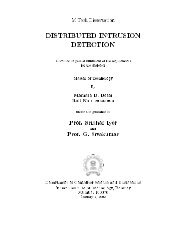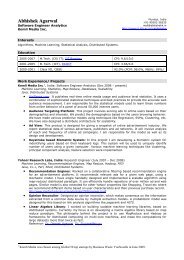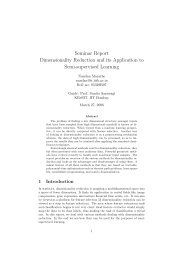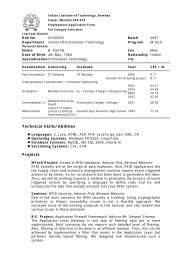A Method to Construct Counterexamples for Greedy Algorithms
A Method to Construct Counterexamples for Greedy Algorithms
A Method to Construct Counterexamples for Greedy Algorithms
You also want an ePaper? Increase the reach of your titles
YUMPU automatically turns print PDFs into web optimized ePapers that Google loves.
Figure 9: A counterexample <strong>to</strong> the weak algorithm<br />
<strong>for</strong> the matching problem.<br />
Adding the auxiliary structure. We attach K 2 <strong>to</strong> each of<br />
the end vertices. This gives a plausible counterexample–the<br />
greedy could pick a matching of size 3 instead of 4. Attaching<br />
K 4 gives a definitive counterexample.<br />
Adding the auxiliary structure. We need <strong>to</strong> make the vertices<br />
of this path as leaves of some tree. We need <strong>to</strong> attach<br />
an auxiliary structure such that the vertices on the path become<br />
leaves. The auxiliary structure cannot have a vertex<br />
with degree greater than 3 since we have <strong>for</strong>ced the greedy<br />
algorithm <strong>to</strong> pick the the leftmost vertex in the anchor first.<br />
The complete binary tree serves this purpose. The counterexample<br />
is shown in Fig. 13.<br />
K 4 K 4<br />
Figure 10: Plausible and definitive counterexamples<br />
<strong>to</strong> the greedy algorithm <strong>for</strong> the matching problem.<br />
4.2 Maximum leaf spanning tree<br />
Problem Definition. Given a graph G = (V, E), the maximum<br />
leaf spanning tree problem(MLS) is <strong>to</strong> find a spanning<br />
tree T in G that has maximum number of leaves; where<br />
leaves are vertices with degree 1. An example is shown in<br />
Fig. 11.<br />
Algorithm. We would like <strong>to</strong> grow the tree along vertices<br />
that branch out well. One heuristic is <strong>to</strong> grow the tree along<br />
a vertex which has the maximum number of neighbors not<br />
in the tree[4].<br />
Notation. For a vertex v in tree T , let N ′ (v) denote the<br />
set of neighbors of v not in T .<br />
The greedy algorithm initializes the tree T with the maximum<br />
degree vertex and then grows the tree along that vertex<br />
u <strong>for</strong> which the size of N ′ (u) is maximized.<br />
Counterexample<br />
Building an Anchor. In the above algorithm, we grow the<br />
tree T along the vertex that has maximum number of neighbors<br />
outside the tree. Consider the weaker algorithm that<br />
does not exercise this choice and instead grows the tree along<br />
any arbitrary vertex.<br />
An instance where the weak algorithm could per<strong>for</strong>m poorly<br />
is shown in Fig.12. The optimal algorithm would pick the<br />
vertex with the highest degree r and obtain a spanning tree<br />
having |V |−1 leaves. But if the weak algorithm picks vertex<br />
l first, it could end up with a spanning tree having only two<br />
leaves (as indicated with dark background).<br />
l<br />
r<br />
Figure 12: A counterexample <strong>to</strong> the weak algorithm<br />
<strong>for</strong> the MLS problem.<br />
Notice that the key <strong>to</strong> designing the weak counterexample<br />
was <strong>to</strong> make the algorithm select a long path of vertices<br />
which should have been selected as leaves. Can we mimic<br />
that behavior <strong>for</strong> the greedy algorithm? We make the greedy<br />
algorithm start from the first node by increasing its degree.<br />
Figure 13: A plausible counterexample <strong>to</strong> the greedy<br />
algorithm <strong>for</strong> the Max-leaf Spanning Tree problem.<br />
4.3 Minimum Steiner tree<br />
Problem Definition. Given a graph G = (V, E) and a<br />
set of terminal vertices P ⊆ V , the minimum Steiner tree<br />
problem (STP) is <strong>to</strong> find a tree T in G such that the following<br />
two conditions are satisfied:<br />
1. Tree T contains all terminal vertices P .<br />
2. The number of edges in T is minimized.<br />
An example is shown in Fig. 14.<br />
e<br />
a<br />
d<br />
b<br />
c<br />
Figure 14: The input graph G with terminals P =<br />
{a, c, d} has a minimum Steiner tree having three<br />
edges. Note that the Steiner tree can contain vertices<br />
not in set P .<br />
Algorithm. Notice that the Steiner tree must connect all<br />
the terminals using the least number of edges. Since any<br />
two terminals must be connected, we try <strong>to</strong> grow the tree<br />
by connecting two vertices along their shortest path.<br />
Definition. For a tree T ∈ G and a vertex v ∈ G, a v ❀ T<br />
connecting path is the shortest path that connects vertex v<br />
<strong>to</strong> some vertex in T .<br />
a<br />
d<br />
b<br />
c

















